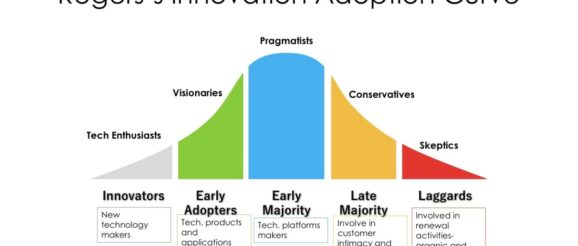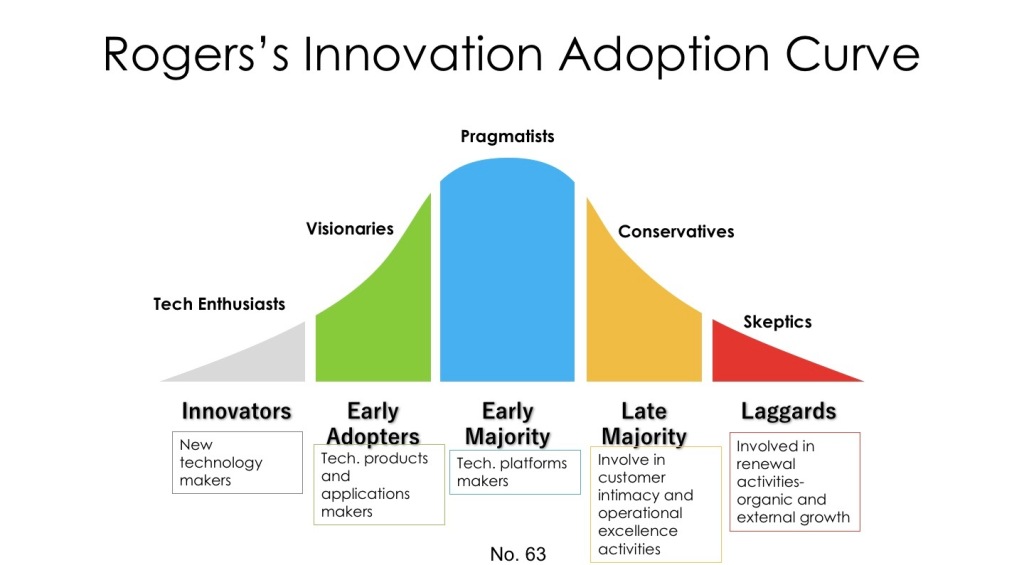What is the adoption curve of innovation, and how does it work?

Concept
Adoption of innovation is popularised by Everett Rogers, arguing how new technology innovation reaches the people and discussing related factors like elements of diffusion, generation of innovation, attributes of innovations and their rates of diffusion, diffusion curve and categories, and more. The diffusion curve illustrates how technology innovation moves from development through implementation to market streams. The diffusion curve follows the normal-probability distribution curve and S-curve and comprises five adopter categories.
These five groups of buyers and developers are:
- Innovators- Techies or ventures.
- Early adopters- Visionaries or entrepreneurs.
- Early majority- Pragmatists.
- Late majority- Conservatives or sceptics.
- Laggards- Traditional.
Besides, adopter categories are members of a social system and are different in the innovativeness perception. These categories are varied, for instance, in the degree and rate of adopting new ideas, drivers to adoption of innovation, attitudes, value desires, channels of adoption, and the timing of adoption.

Background
Everett Rogers argued the diffusion theory of innovation in the book ‘Diffusion of innovations’ in 1962 (first edition). The latest edition of this book reached its fifth edition in 2003.
How does it work?
Everett Rogers’s book ‘Diffusion of innovations’ argued innovation generation, adoption, and categories, as per the following details (Everett Rogers, 2003)1:
Steps for innovation generation
- Identification of problems: recognition of a problem or need may occur when a social problem rises to a high priority, which deserves research.
- Research: many technological innovations result from the research. Research is an original investigation for the advancement of scientific knowledge that does not have the specific aim of applying this knowledge to practical problems. The results of the research may be used in applied research, which comprises scientific investigations to solve practical problems. Lead users develop innovations and then convince a manufacturing company to produce and sell the innovation, often after the lead user has created a prototype of the innovation.
- Development: following the innovation research is the development stage, which is putting a new idea into a form expected to meet the needs of an audience of potential adopters. Development means crafting a solution and prototype and experimenting with it in the marketplace for validation.
- Commercialisation: are efforts, for instance, to make production, packaging, marketing, and distribution of a product that embodies an innovation. Commercialisation is carried out mainly by private firms. A crucial point in the innovation-development process is the decision to diffuse an innovation to potential adopters.
- Diffusion: Finally, an innovation may diffuse, be adopted and cause consequences, and spread to the market through a lifecycle comprising different stages like introduction, growth, maturity, and decline.
Attributes to innovation adoption
Individuals’ perceptions of innovation often predict the innovation’s rate of adoption, which is the relative speed with which members of a social system adopt an innovation. Factors influencing the rate of adoption include: (1) the type of innovation decision, (2) the nature of communication channels diffusing the innovation, (3) the nature of the social system, and (4) the extent of change agents’ efforts in diffusing the innovation.
Innovations have five key attributes:
- Relative advantage: the degree to which an innovation is perceived as better than the idea it supersedes. The relative advantage of an innovation is positively related to the rate of adoption.
- Compatibility: the degree to which an innovation is perceived as consistent with the existing values, experiences, and needs of potential adopters. The compatibility of innovation is positively related to the rate of adoption.
- Complexity: the degree to which an innovation is perceived as relatively difficult to understand and use. The complexity of innovation is negatively related to the rate of adoption.
- Trialability: the degree to which an innovation may be experimented with limitedly. The trialability of innovation is positively related to its rate of adoption.
- Observability: the degree to which the results of an innovation are visible to others. The observability of innovation is positively related to its rate of adoption.
Adoption curve and categories
- Adopter categories are the classifications of the members of a social system based on innovativeness criteria. Such criteria include the degree to which an individual of adoption is relatively earlier in adopting new ideas than other members of a system, the drivers to adopt innovation, channels of adoption, the timing of adoption, and the rate of adoption.
- Adopter distributions follow an S-shaped curve over time and approach normality. The innovation groups of adopters are innovators, early adopters, early majority, late majority, and laggards.
- Finally, the adopter categories have different communication behaviour. Earlier adopters have, for instance, more social participation, more contact with change agents, greater exposure to communication channels (e.g., mass media and personal), and more knowledge of innovations and higher opinion leadership.
- This post is sourced from my new book- Your Guide To Reach Innovation.
Final note: the book- Your Guide To Reach Innovation, is an actionable guide to innovation from beginning to end. Enjoy reading the book, and I look forward to your reviews.
Author: Munther Al Dawood
maldawood@growenterprise.co.uk
Reference:
- Everett Rogers, 2003. Diffusion of innovations, fifth edition, Free Press, New York.
